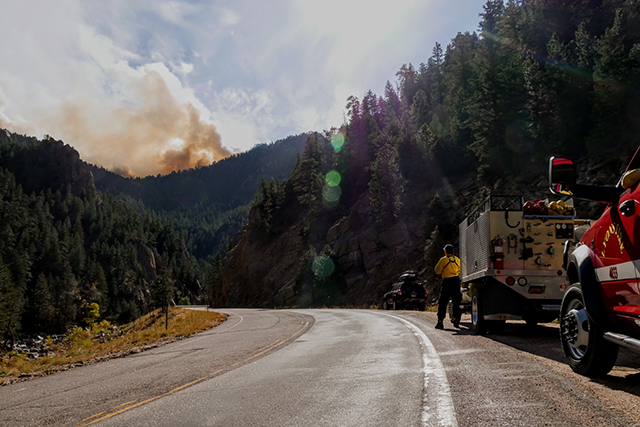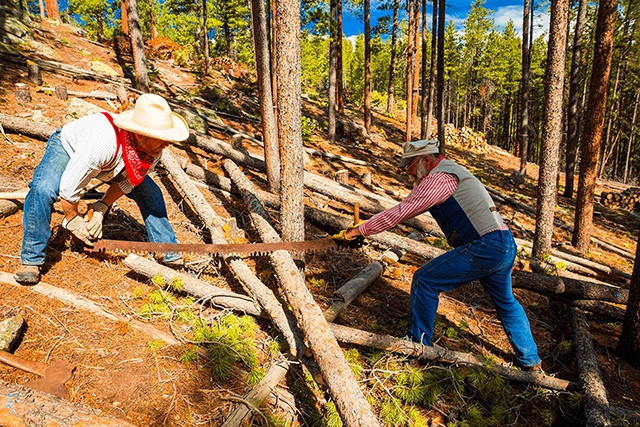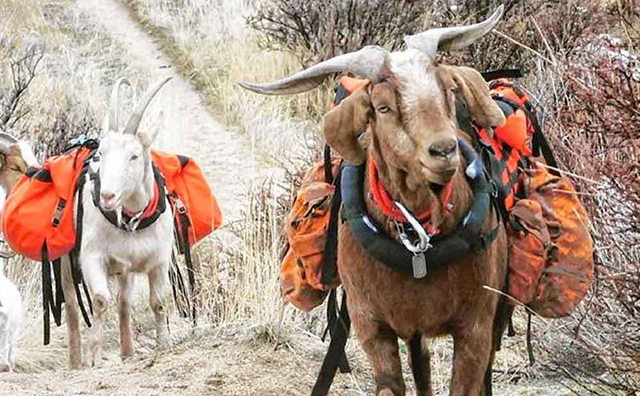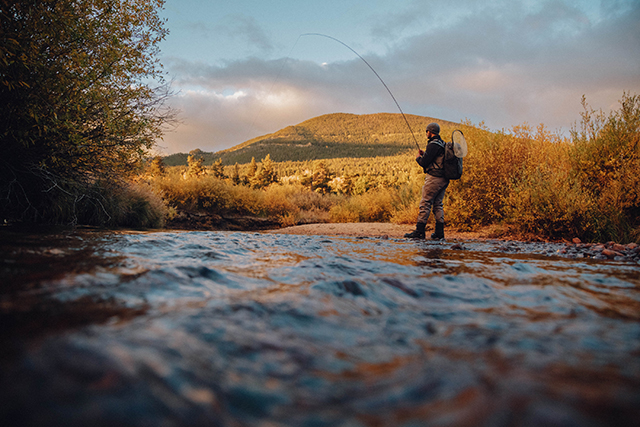Firewise Boulder
02 Aug 2023
How Boulder County officials (and goats) proactively tackle wildfire mitigation
By Teresa McLamb

Smoke from fires hundreds of miles from Boulder have been a reminder that this part of the country, with its high winds and grasslands, is susceptible to the excitable tentacles of wildfire. While unprecedented rainfall this summer has shielded much of the region from plume-filled horizons, officials within Boulder County are still taking precautions to mitigate disaster and introduce emergency action plans to ensure the safety of county residents and wildlife.
Boulder County’s Action Plan
City of Boulder Wildland Fire Division Chief Brian Oliver oversees operations, but he emphasizes that multiple agencies collaborate to ensure swift and effective responses. “We’ve put a lot of work into making evacuations more efficient. We’re rebuilding the dispatch system.” Notably, these enhancements involve a shift from solely addressing incidents within their jurisdiction to dispatching an appropriate number of fire trucks from the nearest available locations, regardless of jurisdiction.
“We’re working on the community wildfire protection plan in partnership with others. There’s a lot of effort going on to maintain best practices. It must be a shared effort. Fire has no boundaries; we all must work together,” says Oliver.
Among the ongoing efforts are forest thinning, livestock grazing, weed management and controlled burns. That said, Boulder County’s Parks & Open Space and Sheriff’s Office Wildland Fire Management Program will only conduct prescribed burns if they can be done safely and align with both city burn goals and state-mandated guidelines.
Educational materials provided online by the county point out that the Boulder area has “evolved with fire for millions of years…helping to shape the diverse wildlife and plant ecosystems we all enjoy today.” While Boulderites have coexisted with wildfire risk, enjoying that space in a safe manner requires regulations. Namely, the prohibition of ignition in Boulder Open Space and Mountain Parks (OSMP) including smoking, campfires and fireworks.
As a recent example, the City of Boulder made a notable decision to substitute a traditional 4th of July firework display with a drone light show to mitigate the risk of wildfires.
The city has additionally created an eight-page booklet describing efforts homeowners can make to combat property damage from a wildfire. “If you don’t know anything about living in an area that’s prone to wildfire, this gives you a good start,” Oliver says. The document includes best practices and construction materials and explains how to identify an ignition zone around a structure. “Most houses are lost from embers landing and igniting fuel next to the home. That radiant heat grows exponentially from home to home, especially in Boulder because of the density of housing,” he says.
Ignition zone protection measures include changes in building materials, removal of flammable materials, such as organic mulch, and limbing trees near the roof line. The most effective fire mitigation efforts are done within five to 10 feet of a structure.
While Oliver says there’s no way to completely protect your home from fire, about 98 percent of fires are kept to an acre through safe and effective response from trained professionals with the right equipment. “It’s that two or three [acres] that get up and build momentum, becoming a large fire. They’re few and far between. The Marshall Fire is a great example of mother nature in charge. When conditions are such, there’s nothing we in the fire department can do. It’s going to run its course. Fire is a force of nature.”
Following the Marshall Fire, the city developed a citywide team to take a more comprehensive approach to wildfire management. They pulled directors from across city departments to meet monthly to ensure efforts were at a city level, not just an individual department. “That’s really going to have a tremendous effect,” Oliver says.

Additional Mitigation Measures
On the county level, numerous mitigation efforts are underway thanks in part to passage of two tax measures, according to Boulder County Fire Management Officer Seth McKinney. One fund addresses mitigation across the county; Wildfire Partners—a wildfire mitigation program to help residents of the mountains and foothills prepare for fire—is administering that effort. Specifically, the program provides onsite wildfire home assessments, performed by a mitigation specialist. With the homeowner, they will examine the trees and other vegetation within what they deem the defensible space zones around the home. They’ll also assess the exterior of the home for potential vulnerabilities to wildfire. The assessment takes about two hours, and they are conducted year-round, weather permitting.
The other is an emergency response tax meant to address a multitude of needs the county had identified pertaining to wildfire-specific items, volunteer rescue needs and rural departments across the county. “A lot of movement is happening that hasn’t come to fruition yet; I support all the mitigation efforts,” McKinney says. Included in the developments will be a new facility for Rocky Mountain Rescue Group, an all-volunteer rescue organization.
McKinney applauds the coordination of fire shed agencies—including the state and federal forest services—working together to collaborate a shared vision. “We recognize a lot of these projects need to be across boundaries and jurisdictions. Our meeting time helps us to get on the same page and coordinate to work together.”

And Then There Were Goats
One unlikely—and adorable—mitigation method used throughout Boulder County is prescribed goat grazing, in which herds of goats are put on the job to reduce vegetation and access hard-to-reach terrain. “For what the goats munch on, they’re more effective in grassy areas,” says McKinney. They are, however, also used in the mountains, he says. In Boulder County, specifically, goat grazers are primarily contracted by residents, rather than agencies.
Lani Malmberg’s herd of 1,200 cashmere goats first worked in Boulder in 1999. She holds a master’s degree in weed science from Colorado State University and grew up on a cattle ranch. Her son, Donny Benz, and his fiancé, Kati Singley, are partners in the business, aptly named Green Goats LLC.
“My goats have eaten all the poisonous plants in all 15 western states we work with no problem. Colorado has 68 noxious weeds, and the goats eat all of them,” Malmberg says. “We have 27 generations of goats who have worked their whole lives for us. We’re on contract every day somewhere. Sometimes it’s all in one herd and sometimes it’s split.” In that case, the off-duty goats are put in a camper and watched by at least one human companion.
To perform their jobs correctly isn’t just a buffet in the park, however. The target area is encased with electric fencing and moved several times throughout the day to change the herd’s grazing area and act as a deterrent to attackers,” Malmberg says. While she’s seen many predators, she’s never had a coyote or bear go through a fence.
Routinely, a goat will eat for four hours and lie down to digest for four more, before they begin to eat again. In the long days of summer, they may eat several times, and, in winter, maybe once. Fortunately, they eat almost any vegetation, making them far more effective grazers than cattle, who primarily eat low grasses. Goats can also stand on their hind feet to eat, often munching on vegetation from tall bushes and trees, effectively clearing the fire fuel ladder—that is, vegetation that allows a flame to climb and intensify. As they’re eating, they also recycle the material.
Their hooved feet atop soil stabilizes the debris on hillsides, reducing the risk of mudslides, Malmberg notes, meaning they can perform soil stabilization tasks after a fire, too.
While most days are peaceful, there have been tense times, including their evacuation from the 2020 Grizzly Creek Fire in Glenwood Canyon with 100 goats. “My son and I and the border collies [who herd the goats] ran down the mountain; lions and bears were running with us. It was pretty cool,” Malmberg remembers.
And, while the heavy rainfall this year has acted as potential retardant to summer flames, Malmberg believes the resulting thick grasses will dry in the fall, creating a potential burn hazard. Climate change plays a role, too. Increasing temperatures and dry conditions are challenges the whole county faces, and officials encourage community preparedness in the face of fire-prone dry soil and vegetation, as well as fast winds.
Ultimately, Colorado residents must proactively prepare for fire incidents and actively collaborate with the agencies responsible for their protection and service. This partnership plays a pivotal role in ensuring safety and reducing wildfire risk.












